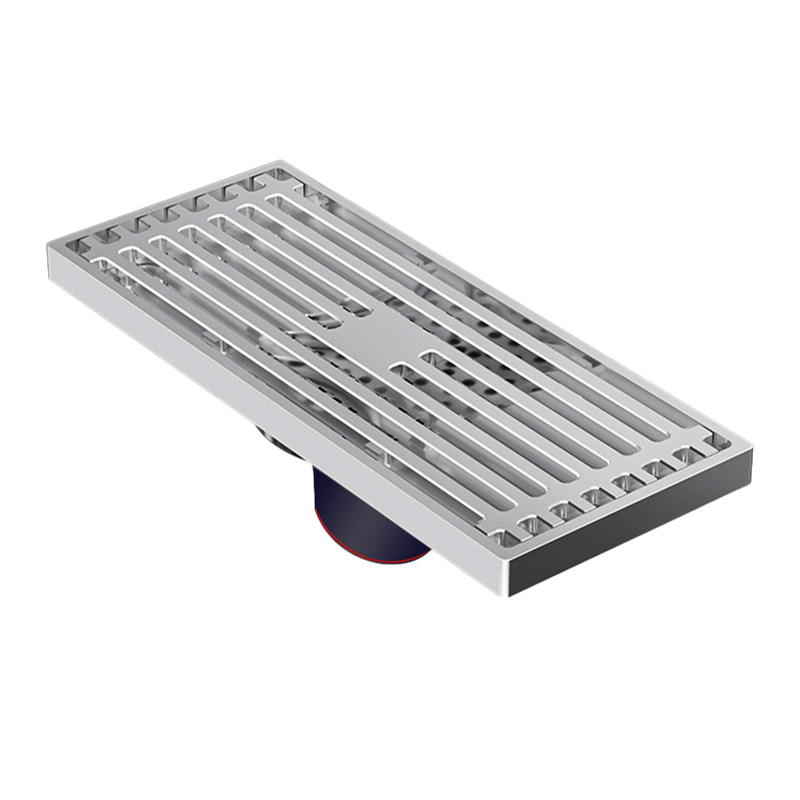Why Does My Shower Drain Stink
A clean, fresh-smelling bathroom is a reflection of hygiene and comfort—but a bad odor coming from the Shower Drain can quickly ruin that. If your shower emits a foul or musty smell, it’s more than just unpleasant—it often signals that bacteria, hair, soap residue, or even mold have accumulated inside your drainage system.
Understanding the root cause of the odor is essential not only to eliminate it but also to prevent it from returning. Our stainless steel shower drains are designed with anti-odor water seals, removable baskets, and advanced drainage technology that solve this problem at its source.
This article explains why shower drains develop bad smells, how to identify the cause, and what steps you can take—both in cleaning and through proper drain design—to keep your bathroom consistently fresh.
1. Common Causes of a Smelly Shower Drain
1.1 Accumulation of Hair and Soap Scum
Hair and soap are the two biggest culprits behind a stinky shower drain. Over time, they mix with skin flakes, shampoo residue, and body oils, forming sticky clumps that trap moisture and bacteria. These deposits decompose slowly, producing a musty or rotten odor that rises through the drain cover.
| Source | Description | Resulting Smell |
|---|---|---|
| Hair buildup | Traps moisture and organic particles | Moldy, earthy odor |
| Soap residue | Reacts with minerals, forming a waxy layer | Sour or chemical-like smell |
| Dead skin & oils | Nutrient source for bacteria | Rotten or sulfuric odor |
Our shower drains include fine filter baskets that trap hair before it enters the pipe, preventing this buildup and making cleaning effortless.
1.2 Dry or Faulty Water Trap
Every properly designed drain has a P-trap or S-trap, a curved section that holds water to block sewer gases from escaping. When this water evaporates or leaks, foul-smelling gases from the sewer line can flow back into the bathroom.
Causes of a dry trap include:
Infrequent shower use, causing water in the trap to evaporate.
Improper installation that prevents the trap from sealing.
Damaged or old seals that allow airflow.
Modern shower drain systems like ours use a built-in water seal with a silicone anti-odor valve, which automatically opens during drainage and closes afterward to block gases and insects—eliminating the risk of sewer smell leaks.
1.3 Mold and Mildew Growth
Bathrooms are naturally humid environments, which makes them ideal breeding grounds for mold. The underside of a drain cover or the space around the trap often stays damp and dark, allowing mold and mildew to flourish. As these microorganisms grow, they emit a persistent musty odor that spreads through the room.
| Area | Cause | Odor Type | Solution |
|---|---|---|---|
| Drain cover | Moisture under metal grate | Musty smell | Remove cover, clean with vinegar |
| Tile joints | Poor sealing or hidden leaks | Damp smell | Re-grout and dry area |
| Trap region | Constant humidity | Stale odor | Use anti-odor sealing core |
Our shower drains are made of SUS304 stainless steel, which resists corrosion and mold buildup, ensuring cleanliness and hygiene even in wet conditions.
1.4 Bacterial or Biofilm Accumulation
A biofilm is a sticky layer of bacteria that forms inside pipes where organic matter collects. This layer produces hydrogen sulfide gas—the same compound responsible for the rotten egg smell.
Poorly designed or plastic drains allow biofilm to attach and thrive, but a smooth stainless steel surface with efficient drainage flow minimizes bacterial adhesion.
2. How to Identify the Source of the Odor
Pinpointing the exact cause of the odor helps determine the right cleaning or maintenance approach. Here’s how to locate the source step by step.
2.1 Inspect the Drain Cover
Remove the metal grate or tile insert cover.
Check for visible hair, soap residue, or mold spots.
If you notice discoloration or slimy buildup, this is a likely source.
Clean it thoroughly with hot water and mild detergent.
2.2 Check the Strainer Basket
If your shower drain includes a removable basket, lift it out to inspect what’s collected.
Remove hair and debris using gloves.
Rinse under hot water and scrub gently with a soft brush.
Reinstall the basket properly to maintain its function.
| Part | What to Check | Possible Issue | Fix |
|---|---|---|---|
| Cover | Mold or residue | Stale smell | Wash with vinegar |
| Basket | Hair, dirt | Decomposing matter | Clean weekly |
| Trap | Dry or cracked | Sewer gas smell | Pour water or replace seal |
2.3 Smell the Drain Pipe
If the odor persists even after cleaning the surface:
Shine a flashlight down the drain.
If there’s standing water, the trap is functioning.
If it’s dry, refill it by pouring a liter of clean water.
Persistent sewer-like smells may indicate that the trap or vent pipe needs inspection.
Our shower drains use mechanical water seals and silicone one-way traps to prevent this issue entirely.
3. Effective Solutions to Eliminate and Prevent Drain Odors
3.1 Regular Cleaning Routine
Routine cleaning is the most effective way to keep odors away. You can use simple household materials instead of harsh chemicals.
| Step | Product | Purpose |
|---|---|---|
| 1 | Hot water rinse | Loosens debris and soap scum |
| 2 | Baking soda (½ cup) | Neutralizes odor and dissolves residue |
| 3 | White vinegar (1 cup) | Reacts with soda to remove buildup |
| 4 | Wait 15 minutes | Allows foaming action to clean deep surfaces |
| 5 | Final hot water flush | Rinses out loosened debris |
Tip: Repeat this process weekly to keep the drain interior clean and odor-free.
3.2 Use an Anti-Odor Shower Drain
Installing a modern anti-odor shower drain is a long-term solution. Our designs include:
Silicone water seals that automatically block gas return.
Removable stainless steel baskets that catch hair and soap particles.
Slope-based design that ensures complete water discharge after use.
This prevents water stagnation—the main source of bacteria and odor. The combination of efficient flow and high-grade stainless steel keeps your bathroom smelling clean at all times.
| Feature | Function | Benefit |
|---|---|---|
| Anti-odor water seal | Blocks gas return | Prevents foul smells |
| Removable strainer | Captures debris | Easy cleaning |
| 304 stainless steel | Corrosion-resistant | Long-lasting hygiene |
| High-flow outlet | Quick drainage | No stagnant water |
3.3 Maintain Proper Ventilation
Ventilation is crucial for reducing humidity and stopping mold growth:
Run the bathroom exhaust fan for 15 minutes after each shower.
Open windows or doors to allow air circulation.
Wipe down walls and floors to remove moisture.
Keep drain covers dry after cleaning to minimize bacterial buildup.
3.4 Deep Cleaning Every Month
A deeper clean every month prevents stubborn buildup:
Remove the cover and basket.
Soak both in warm soapy water for 10–15 minutes.
Scrub gently using a brush to remove film or rust.
Clean the drain interior using a mild bleach solution (1:10 ratio with water).
Rinse thoroughly and let air dry before reassembly.
For stainless steel surfaces, use a non-abrasive cleaner to maintain their polished look.
4. Choosing the Right Shower Drain to Prevent Odor Permanently
While cleaning helps temporarily, the design of the shower drain itself determines whether odors will keep coming back. Cheap plastic drains often warp, trap water, and accumulate bacteria, whereas stainless steel drains with integrated sealing systems prevent odors naturally.
4.1 Advanced Shower Drain Structure
Our professional shower drains combine mechanical precision and hygiene design:
| Layer | Function | Material |
|---|---|---|
| Top Grate | Filters large debris, supports tile finish | SUS304 stainless steel |
| Filter Basket | Collects hair and soap scum | Perforated stainless steel |
| Drain Base | Channels water into the outlet smoothly | Anti-corrosive stainless steel |
| Water Seal Unit | Prevents gas, odor, and insects | Silicone valve core |
| Outlet Connector | Provides secure connection to piping | PVC or stainless steel |
This construction ensures that odor-causing gases cannot escape, while water flows freely and efficiently.
Unlike traditional models, our drains use gravity-assisted sealing and replaceable odor traps, combining aesthetics with functionality.
4.2 Benefits of Upgrading to a Modern Drain System
Upgrading your existing drain is one of the most effective ways to eliminate odor problems permanently.
Advantages include:
No stagnant water: High-flow design removes water immediately after use.
No sewer smell: Built-in anti-odor valve blocks backflow gases.
Easy maintenance: Removable parts simplify cleaning.
Enhanced hygiene: Smooth surfaces prevent bacterial growth.
Modern aesthetics: Sleek square or hidden circular designs match any tile style.
By choosing a high-quality stainless steel shower drain, you eliminate the root causes of odor—rather than just masking the smell temporarily.
Conclusion
If your shower drain stinks, the problem likely lies in hair buildup, trapped residue, a dry water trap, or bacteria growth. While cleaning can temporarily remove the smell, the most effective and lasting solution comes from using a well-designed shower drain equipped with an anti-odor sealing system.
Our stainless steel shower drains feature innovative multi-layer structures, odor-trapping seals, and removable strainers to maintain a clean and fresh bathroom environment. They prevent the accumulation of debris and block gases from rising, ensuring both hygiene and long-term comfort.
With proper cleaning habits and the right drain design, you can say goodbye to unpleasant shower drain odors—keeping your bathroom smelling fresh, modern, and inviting every single day.
Previous: Why Is My Shower Draining Slow




